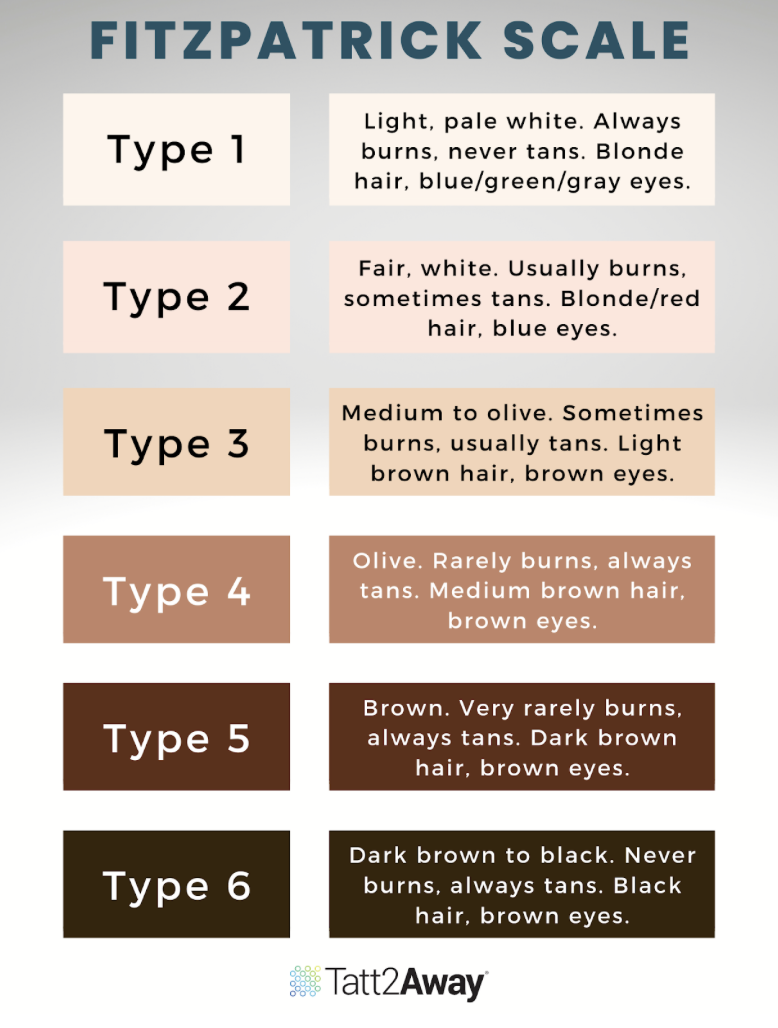The Fitzpatrick Scale: How Tatt2Away® Works for Different Skin Tones

The Fitzpatrick scale is a numerical classification system that is used to categorize different skin tones based on their response to sunlight. Developed in 1975, the Fitzpatrick scale has become a widely accepted tool in the field of dermatology.
The scale ranges from Type I, which refers to very fair skin that always burns and never tans, to Type VI, which refers to very dark skin that never burns and always tans. The Fitzpatrick scale is used by dermatologists and other medical professionals to determine the appropriate treatment for a particular skin type, as well as to assess the risk of skin reactions and other sun-related skin conditions.
In tattoo removal, the Fitzpatrick scale is used to determine any possible risks or skin reactions that might come with removing a tattoo, such as keloids or hyper/hypo pigmentation.
Tatt2Away: The Safe and Effective Alternative to Laser Tattoo Removal


When it comes to tattoo removal, laser tattoo removal has limitations that Tatt2Away does not have. When it comes to removing certain inks on certain skin tones (keep reading for details!), laser tattoo removal can be harmful. With Tatt2Away, though, there are very few limitations since it is a microdermabrasion technique. Tatt2Away is able to remove tattoos on any skin tone, with little to no risk of damaging the skin or body. Darker skin tones may sometimes encounter adverse reactions, which is why we ask each client to come in.
Removing Tattoo Ink on Darker Skin Tones – Tatt2Away



There are no specific Fitzpatrick limitations to using microdermabrasion for tattoo removal since it does not target the pigment in the tattoo ink in the same way that laser tattoo removal does. However, darker skin types on the Fitzpatrick scale may be more prone to developing hyperpigmentation or scarring after microdermabrasion.
This is because the procedure can sometimes cause small injuries to the skin, which may trigger an overproduction of melanin or collagen in the affected area. As a result, it is important for individuals with darker skin types to work with a trained and experienced professional who can monitor their skin’s response to the treatment and adjust the procedure as necessary to minimize the risk of adverse effects.
This is why we may opt for a spot test on clients, so we are able to test how your skin might react to tattoo removal.
To learn more about the Tatt2Away removal process and how it works, check out our website.
The Challenges of Laser Wavelengths on Different Skin Tones
The Fitzpatrick scale can play a significant role in tattoo removal because it helps to determine the potential risks associated with the procedure. When it comes to laser tattoo removal, people with darker skin types, such as Types IV, V, and VI on the Fitzpatrick scale, are at a higher risk of developing hypopigmentation or hyperpigmentation, which are changes in skin color that can occur after tattoo removal.
This is because the lasers used in tattoo removal target the pigment in the skin and can inadvertently affect the surrounding skin. Additionally, people with darker skin types may also be more prone to scarring or keloid formation after tattoo removal. As a result, it is important for individuals with darker skin types to seek out a skilled and experienced tattoo removal professional who can tailor the treatment to their specific needs and minimize the risk of adverse effects.
Red Ink on Darker Skin Types – Laser Tattoo Removal
Red ink can be more difficult to remove on darker skin tones because the laser used in tattoo removal targets pigment, and the color red absorbs light differently than other colors. Specifically, red ink and warm ink tones require a specific wavelength of light to be absorbed by the ink particle, which also happens to be heavily absorbed by melanin and melanocytes as well, which causes the damage we see when treating red ink with lasers (i.e. hypopigmentation and scarring).
This makes it more challenging to target with the laser without also affecting the surrounding skin. As a result, it is generally recommended that people with darker skin tones avoid getting tattoos with red ink in the first place, or at least be aware that red ink may be more challenging to remove with laser tattoo removal.
Alternative Methods May Work Better
Other removal methods, such as microdermabrasion with Tatt2Away, may be more effective for removing red ink tattoos on darker skin tones.
